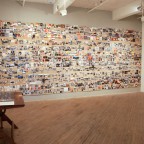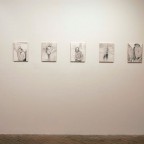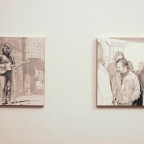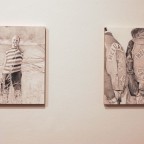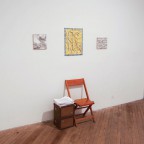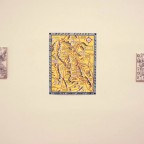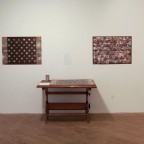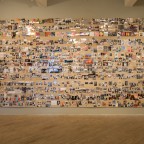
“The demon only exists because the two equations look alike.”
The World (This one) is an exhibition that focuses on the process and results of Stockton’s in-depth, non-linear investigation into the rise of 1960s Californian counterculture. He begins with the interconnected trajectories of two seemingly very different icons: the cult leader Charles Manson (and his “Family”) and the subculture author Ken Kesey (and his “Merry Pranksters”).
The exhibition features eight new drawings that are accompanied by a network of hundreds of images of supplemental source material – visual ephemera such as book jackets, historic photographs, maps, and album covers. The organization of this vast network of printed images elucidates the complex interconnectedness of the key figures while revealing the feedback loop of this type of investigation – in which the act of looking for coincidences produces them.
Stockton began by mining seminal non-fiction accounts from the time period – first Helter Skelter by Vincent Bugilosi and Curtis Gentry, and then Electric Kool-Aid Acid Test by Tom Wolfe. But as his research accumulated into a labyrinth of visual maps, timelines, non-fiction accounts and internet searches, anticipated paths disintegrated into a vast network of sensationalist common points:
LSD… Helter Skelter… Project MKUltra… Scientology…. Orgies…. Hell’s Angels… Death Valley…The SeaOrg… Laurel Canyon… Black Magic… Assassinations… E-meters… Pedophiles… OT Levels… Satanic rituals… Tristero… Maxwell’s Demon… Clears…. Purple Haze… Altamont… Orange Sunshine… Secret Societies… Cults… Berkeley Radicals…. Sound Stage Moon Landings… and Further
The accumulation of “evidence” is overwhelming, producing more questions than tangible answers; yet, it manifests the ambition, experimentation and paranoia of mid 20th century counterculture. Stockton’s interest in this collection of subjects is primarily visual; his drawing process allows him to reflect on the iconic figures of this complex time period. The two parts of this show – the drawings and the research – are strong contrasts to one another. Where the drawings maintain focus in re-constructing empirical images, the research has metastasized into an abundant physical representation of prints, a process of visual links that indulges in the vast conspiracy-laden echo-chamber of the internet. In this space, facts, half-truths, suspicion and hear-say become equivalents in forming an ominous ungraspable cloud of information.


